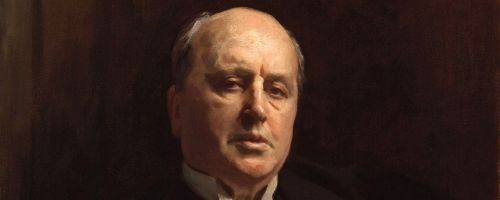Order of Henry James Books

Henry James (1843-1916) was an American-British author of literary fiction novels and stories. A common theme in his novels was American ex-pats living in Europe. His plots were based around personal relationships, the proper usage of power in such relationships, and other moral questions. His imaginative use of point of view, interior monologue and unreliable narrators in his work brought an extra layer of depth to realistic fiction, and foreshadowed the modernist work of the 20th century. James was a prolific writer, in addition to his many works of fiction, he published articles and books on a variety of topics and wrote plays, some of which were performed during his lifetime to some success.
Henry James made his debut as a novelist in 1871 with the novel Watch and Ward. Prior to that, he had published the play Pyramus and Thisbe in 1869. Below is a list of Henry James’ books in order of when they were originally released:
Publication Order of Standalone Novels
Publication Order of Short Stories/Novellas
Publication Order of Short Story Collections
| Selected Tales | (1866) | Description / Buy at Amazon.com |
| Complete Stories, 1864–1874 | (1874) | Description / Buy at Amazon.com |
| Complete Stories, 1874–1884 | (1884) | Description / Buy at Amazon.com |
| Complete Stories, 1884–1891 | (1891) | Description / Buy at Amazon.com |
| Ghost Stories of Henry James | (1898) | Description / Buy at Amazon.com |
| Complete Stories, 1892–1898 | (1898) | Description / Buy at Amazon.com |
| The Finer Grain | (1910) | Description / Buy at Amazon.com |
| Complete Stories, 1898–1910 | (1910) | Description / Buy at Amazon.com |
| Selected Poems of Henry James | (2002) | Description / Buy at Amazon.com |
| The New York Stories of Henry James | (2011) | Description / Buy at Amazon.com |
Publication Order of Plays
| Pyramus and Thisbe | (1869) | Description / Buy at Amazon.com |
Publication Order of' Memoirs Non-Fiction Books
| A Small Boy and Others | (1913) | Description / Buy at Amazon.com |
| Notes of a Son and Brother | (1914) | Description / Buy at Amazon.com |
| The Middle Years | (1917) | Description / Buy at Amazon.com |
Publication Order of Non-Fiction Books
| The Novels of George Eliot | (1866) | Description / Buy at Amazon.com |
| How to Play Golf | (1869) | Description / Buy at Amazon.com |
| The Guest's Confession | (1872) | Description / Buy at Amazon.com |
| The Complete Letters of Henry James, 1855–1872: Volume 1 | (1872) | Description / Buy at Amazon.com |
| Parisian Sketches: Letters to the New York Tribune, 1875-1876 | (1875) | Description / Buy at Amazon.com |
| The Complete Letters of Henry James, 1872–1876: Volume 2 | (1876) | Description / Buy at Amazon.com |
| The Complete Letters of Henry James, 1872–1876: Volume 3 | (1876) | Description / Buy at Amazon.com |
| The Suburbs of London | (1877) | Description / Buy at Amazon.com |
| Hawthorne | (1879) | Description / Buy at Amazon.com |
| French Poets and Novelists | (1883) | Description / Buy at Amazon.com |
| The Letters of Henry James, Volume II | (1883) | Description / Buy at Amazon.com |
| A Little Tour in France | (1884) | Description / Buy at Amazon.com |
| Partial Portraits | (1888) | Description / Buy at Amazon.com |
| Terminations | (1895) | Description / Buy at Amazon.com |
| The Painter's Eye | (1897) | Description / Buy at Amazon.com |
| The Better Sort | (1903) | Description / Buy at Amazon.com |
| English Hours | (1905) | Description / Buy at Amazon.com |
| Traveling in Italy with Henry James | (1907) | Description / Buy at Amazon.com |
| Italian Hours | (1909) | Description / Buy at Amazon.com |
| The Art of the Novel | (1909) | Description / Buy at Amazon.com |
| Letters to Isabella Stewart Gardner | (1914) | Description / Buy at Amazon.com |
| Notes on Novelists with Some Other Notes by Henry James | (1914) | Description / Buy at Amazon.com |
| The Correspondence of Henry James and Henry Adams, 1877-1914 | (1914) | Description / Buy at Amazon.com |
| Selected Letters of Henry James to Edmund Gosse, 1882 1915 | (1915) | Description / Buy at Amazon.com |
| Henry James on Culture | (1917) | Description / Buy at Amazon.com |
| Letters to A.C. Benson and Auguste Monod | (1930) | Description / Buy at Amazon.com |
| William and Henry James: Selected Letters | (1955) | Description / Buy at Amazon.com |
| Selected Literary Criticism | (1963) | Description / Buy at Amazon.com |
| The Complete Notebooks of Henry James | (1984) | Description / Buy at Amazon.com |
| Collected Travel Writings | (1993) | Description / Buy at Amazon.com |
| The American Scene | (1994) | Description / Buy at Amazon.com |
| On Provence | (2014) | Description / Buy at Amazon.com |
| Within the Rim and Other Essays | (2015) | Description / Buy at Amazon.com |
Publication Order of The Dark Descent Books
| Volume I: The Color of Evil | (1987) | Description / Buy at Amazon.com | ||
| Volume II: The Medusa In The Shield | (1990) | Description / Buy at Amazon.com | ||
| Volume III:A Fabulous, Formless Darkness | (1991) | Description / Buy at Amazon.com | ||
+ Show All Books in this Series | ||||
Publication Order of Anthologies
If You Like Henry James Books, You’ll Love…
Henry James Synopses: The American by Henry James is a standalone novel. Christopher Newman is a self-made American millionaire ex-pat living in France. It is there that he falls in love with the beautiful aristocrat Claire de Bellegarde. Her family, however, taken aback by his brash American manner, rejects his proposal of marriage. When Newman discovers a guilty secret in the Bellegardes’ past, he confronts a moral dilemma: Should he expose them, thereby gaining his revenge?
The Europeans by Henry James is a standalone title. Restless Baroness Eugenia Munster and her charming bohemian brother Felix are visiting their American cousins in Boston, New England. The effect these two extravagant characters have on their austere Puritan relations forms the substance of the book and is told in a series of scenes or “sketches.”

